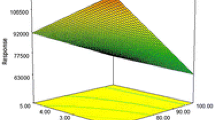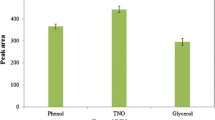Abstract
Ultrasonic-assisted magnetic dispersive solid-phase microextraction coupled with high performance liquid chromatography has been developed for extraction and determination of mirtazapine, N-desmethyl mirtazapine, and 8-hydroxy mirtazapine in human urine and water samples. Magnetic graphene oxide–polyaniline nanocomposite (MGOPA) as a novel SPME sorbent was synthesized and used for the microextraction process. The analytical performance of MGOPA was compared with magnetic graphene oxide nanocomposite and indicated that the new sorbent was quite effective for extraction of mirtazapine, N-desmethyl mirtazapine, and 8-hydroxy mirtazapine. A two-stage experimental design approach, Plackett-Burman screening design and Box-Behnken optimization design, was used for screening and optimizing of significant variables in the microextraction process. The practical applicability of the proposed method was assessed by studying the linearity, intra-day and inter-day accuracy, enrichment factor, and precision. This method can be satisfactorily applied to the determination of mirtazapine and its metabolites in human urine and environmental water samples.

Magnetic graphene oxide–polyaniline nanocomposite






Similar content being viewed by others
References
Brooks BW, Chambliss CK, Stanley JK, Ramirez A, Banks KE, Johnson RD, et al. Determination of select antidepressants in fish from an effluent‐dominated stream. Environ Toxicol Chem. 2005;24(2):464–9.
Stanley JK, Ramirez AJ, Chambliss CK, Brooks BW. Enantiospecific sublethal effects of the antidepressant fluoxetine to a model aquatic vertebrate and invertebrate. Chemosphere. 2007;69(1):9–16.
Alawi M, Alahmad W. Simultaneous determination of some pharmaceuticals in hospital effluents using HPLC with UV and fluorescence detectors. Jordan J Pharm Sci. 2012;5(1).
Ghorbani M, Chamsaz M, Rounaghi GH. Ultrasound‐assisted magnetic dispersive solid‐phase microextraction: a novel approach for the rapid and efficient microextraction of naproxen and ibuprofen employing experimental design with high‐performance liquid chromatography. J Sep Sci. 2016;39(6):1082–9.
Giorgi M, Yun H. Pharmacokinetics of mirtazapine and its main metabolites in Beagle dogs: a pilot study. Vet J. 2012;192(2):239–41.
Timmer CJ, Sitsen JA, Delbressine LP. Clinical pharmacokinetics of mirtazapine. Clin Pharmacokinet. 2000;38(6):461–74.
Timmer C, Paanakker J, Van Hal H. Pharmacokinetics of mirtazapine from orally administered tablets: influence of gender, age, and treatment regimen. Hum Psychopharm Clin. 1996;11(6):497–509.
Brockmöller J, Meineke I, Kirchheiner J. Pharmacokinetics of mirtazapine: enantioselective effects of the CYP2D6 ultra rapid metabolizer genotype and correlation with adverse effects. Clin Pharmacol Ther. 2007;81(5):699–707.
Enggaard TP, Mikkelsen SS, Zwisler ST, Klitgaard NA, Sindrup SH. The effects of gabapentin in human experimental pain models. Scand J Pain. 2010;1(3):143–8.
Deng H, Teo AKL, Gao Z. An interference-free glucose biosensor based on a novel low potential redox polymer mediator. Sensor Actuat B Chem. 2014;191:522–8.
Allafchian AR, Majidian Z, Ielbeigi V, Tabrizchi M. A novel method for the determination of three volatile organic compounds in exhaled breath by solid-phase microextraction–ion mobility spectrometry. Anal Bioanal Chem. 2016;408(3):839–47.
Saraji M, Jafari MT, Sherafatmand H. Sol–gel/nanoclay composite as a solid-phase microextraction fiber coating for the determination of organophosphorus pesticides in water samples. Anal Bioanal Chem. 2015;407(4):1241–52.
Feng J, Sun M, Bu Y, Luo C. Development of a functionalized polymeric ionic liquid monolith for solid-phase microextraction of polar endocrine disrupting chemicals in aqueous samples coupled to high-performance liquid chromatography. Anal Bioanal Chem. 2015;407(23):7025–35.
Ghorbani M, Chamsaz M, Rounaghi GH. Glycine functionalized multiwall carbon nanotubes as a novel hollow fiber solid-phase microextraction sorbent for preconcentration of venlafaxine and o-desmethylvenlafaxine in biological and water samples prior to determination by high-performance liquid chromatography. Anal Bioanal Chem. 2016;408(16):4247–56.
Mahpishanian S, Sereshti H. Graphene oxide-based dispersive micro-solid phase extraction for separation and preconcentration of nicotine from biological and environmental water samples followed by gas chromatography-flame ionization detection. Talanta. 2014;130:71–7.
Daneshvar Tarigh G, Shemirani F. Development of a selective and pH-independent method for the analysis of ultra trace amounts of nitrite in environmental water samples after dispersive magnetic solid phase extraction by spectrofluorimetry. Talanta. 2014;128:354–9.
Wen Y, Niu Z, Ma Y, Ma J, Chen L. Graphene oxide-based microspheres for the dispersive solid-phase extraction of non-steroidal estrogens from water samples. J Chromatogr A. 2014;1368:18–25.
Xue X, Yang D, Wang D, Xu X, Zhu L, Zhao Z. Solidification of floating organic drop liquid‐phase microextraction cell fishing with gas chromatography–mass spectrometry for screening bioactive components from Amomum villosum Lour. Biomed Chromatogr. 2015;29(4):626–32.
Du D, Wang L, Shao Y, Wang J, Engelhard MH, Lin Y. Functionalized graphene oxide as a nanocarrier in a multienzyme labeling amplification strategy for ultrasensitive electrochemical immunoassay of phosphorylated p53 (S392). Anal Chem. 2011;83(3):746–52.
Liu Y, Deng R, Wang Z, Liu H. Carboxyl-functionalized graphene oxide–polyaniline composite as a promising supercapacitor material. J Mater Chem. 2012;22(27):13619–24.
Abedi H, Ebrahimzadeh H. Electromembrane‐surrounded solid‐phase microextraction coupled to ion mobility spectrometry for the determination of nonsteroidal anti‐inflammatory drugs: a rapid screening method in complicated matrices. J Sep Sci. 2015;38(8):1358–64.
Ebrahimzadeh H, Yamini Y, Kamarei F. Optimization of dispersive liquid–liquid microextraction combined with gas chromatography for the analysis of nitroaromatic compounds in water. Talanta. 2009;79(5):1472–7.
Zhang J, Liang Z, Li S, Li Y, Peng B, Zhou W, et al. In-situ metathesis reaction combined with ultrasound-assisted ionic liquid dispersive liquid–liquid microextraction method for the determination of phenylurea pesticides in water samples. Talanta. 2012;98:145–51.
Ferreira SC, Bruns R, Ferreira H, Matos G, David J, Brandao G, et al. Box-Behnken design: an alternative for the optimization of analytical methods. Anal Chim Acta. 2007;597(2):179–86.
Khodadoust S, Ghaedi M, Hadjmohammadi M. Dispersive nano solid material-ultrasound assisted microextraction as a novel method for extraction and determination of bendiocarb and promecarb: response surface methodology. Talanta. 2013;116:637–46.
Acknowledgments
The authors gratefully acknowledge support of this research by the Ferdowsi University of Mashhad, Mashhad, Iran (no.3/32789 dated 12/21/2014).
Author information
Authors and Affiliations
Corresponding author
Ethics declarations
Conflict of interest
The authors declare no conflict of interest.
The study has been carried out in accordance with the ethical standards of the institutional and/or national research committee and with the 1964 Helsinki declaration and its later amendments or comparable ethical standards.
The human urine samples were collected from voluntary donors with their informed consent.
Electronic supplementary material
Below is the link to the electronic supplementary material.
ESM 1
(PDF 236 kb)
Rights and permissions
About this article
Cite this article
Ghorbani, M., Chamsaz, M., Rounaghi, G.H. et al. Development of a novel ultrasonic-assisted magnetic dispersive solid-phase microextraction method coupled with high performance liquid chromatography for determination of mirtazapine and its metabolites in human urine and water samples employing experimental design. Anal Bioanal Chem 408, 7719–7729 (2016). https://doi.org/10.1007/s00216-016-9869-1
Received:
Revised:
Accepted:
Published:
Issue Date:
DOI: https://doi.org/10.1007/s00216-016-9869-1




